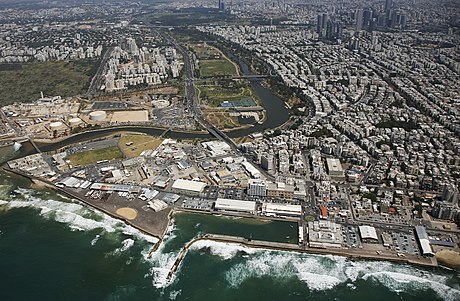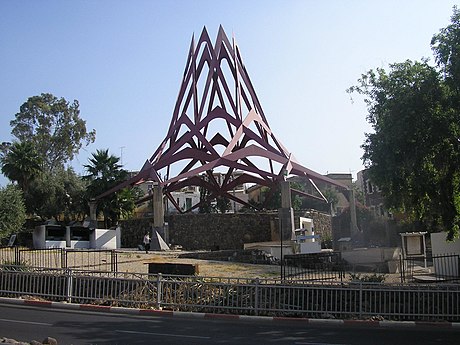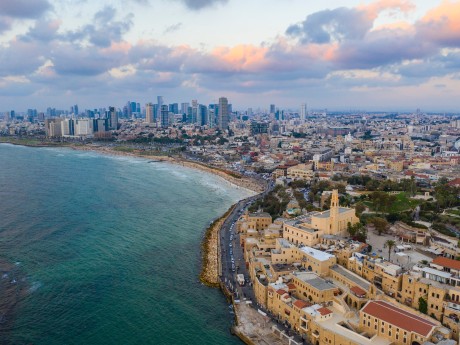Israel: Tel Aviv & Tiberias
Embark on a captivating journey through Israel, beginning in the bustling metropolis of Tel Aviv. This city offers a dynamic mix of vibrant nightlife, pristine beaches, and a rich cultural tapestry. Wander through the charming Neve Tzedek neighborhood, immerse yourself in the lively atmosphere of the Carmel Market, and admire contemporary masterpieces at the Tel Aviv Museum of Art.
Read more
Embark on a captivating journey through Israel, beginning in the bustling metropolis of Tel Aviv. This city offers a dynamic mix of vibrant nightlife, pristine beaches, and a rich cultural tapestry. Wander through the charming Neve Tzedek neighborhood, immerse yourself in the lively atmosphere of the Carmel Market, and admire contemporary masterpieces at the Tel Aviv Museum of Art. After soaking in the urban delights, transition to the serene landscapes of Tiberias, perched on the western shore of the Sea of Galilee. Here, the tranquil ambiance contrasts with the city's historical and religious significance. Enjoy a soothing soak in the therapeutic hot springs, visit the ancient Tiberias Synagogue, and take a peaceful boat ride on the Sea of Galilee. As the day ends, witness a breathtaking sunset over the water, encapsulating the blend of history, spirituality, and natural beauty that defines Tiberias. Waterviews strives to offer accommodation options within walking distance of water and/or in an area of touristic interest. Our prices include taxes (but excludes local tourist taxes). Customize your trip to your personal preferences with optional activities (hit the “Add Activities’’) or change hotels, etc. Contact us for customization at no extra cost at: Service@waterviewstravel.com
Destinations
- Tel Aviv
- Tiberias
Itinerary
Tel Aviv

Tel Aviv (Hebrew: תל אביב, Arabic: تل أبيب) is the second largest city in Israel (after Jerusalem), and the largest metropolitan area. It is on the Mediterranean coast, about 60 km northwest of Jerusalem and 100 km south of Haifa. The official name is Tel Aviv-Yafo (תל אביב-יפו), and reflects the fact that the city has grown beside (and absorbed) the ancient port city of Yafo (English: Jaffa, Arabic: يافا Yafa), to the south of the new city center. Tel Aviv is home to most foreign embassies in Israel.
Read more
Tel Aviv (Hebrew: תל אביב, Arabic: تل أبيب) is the second largest city in Israel (after Jerusalem), and the largest metropolitan area. It is on the Mediterranean coast, about 60 km northwest of Jerusalem and 100 km south of Haifa. The official name is Tel Aviv-Yafo (תל אביב-יפו), and reflects the fact that the city has grown beside (and absorbed) the ancient port city of Yafo (English: Jaffa, Arabic: يافا Yafa), to the south of the new city center. Tel Aviv is home to most foreign embassies in Israel.
Additional Information
The smallish gulf of Jaffa was the site of a fortified port town for at least 4000 years. During the 19th century the town’s population grew from about 2,500 (1806) to 17,000 (1886). The old city walls could no longer contain the population, and they were destroyed in the 1870s. New, more spacious neighborhoods started to appear.
Tel Aviv (meaning literally "Hill of Spring") was founded in 1909 by a group of distinguished Jewish residents of Jaffa. They envisaged a European-style garden suburb, with wide streets and boulevards. Leaving Jaffa wasn’t, however, only a question of an upgrade in lifestyle. Moving out of the Arab-dominated town also represented their belief in the Jewish national movement, Zionism. Before being a city, Tel Aviv was one of the many titles of Theodor Herzl's utopian Zionist book - The Old New Land. Setting out with a grand vision, the 60 Tel Aviv founders started out by building the first mid-eastern urban center with running water, no small wonder in that part of the world in 1909. Houses from this period can still be seen in the Neve Tzedek neighborhood.
Tel Aviv grew steadily under Ottoman law until World War I. By the end of the war the British took over the Holy Land: an event the Jewish community saw as encouraging, while the Muslim community viewed it as a turn for the worse after Islamic rule. Tel Aviv was seen by nearby Arabs as a symbol of the growing Jewish presence in their homeland. In May 1921, an Arab mob attacked a Jewish immigration center, killing dozens of Jews. Another group broke the windows of stores in the Jewish street in Jaffa, and a mob armed with knives and sticks made its way towards Tel Aviv. Before 1921 most Jews worked and lived in Jaffa; after the attack, thousands of the 16,000 Jews of Jaffa moved north to Tel Aviv. The suburb had become a city and within a decade, Tel Aviv had become the center of culture, commerce and light industry for the entire Jewish population of the country (and the British soldiers). 1938 marked the opening of Tel Aviv port, an important milestone in the end of its dependency on Jaffa. By this time, Tel Aviv was already the biggest city in the country, with 130,000 residents. After Israel’s declaration of independence in 1948, Jaffa became a district of Tel Aviv and the city's name was officially changed to Tel Aviv-Yafo.
Today, Tel Aviv-Yafo is the heart of a thriving metropolis. The greater metropolitan area is home to approximately 3.1 million people, with around 392,700 in Tel Aviv-Yafo itself, making it the second largest city in Israel after Jerusalem. Major suburbs of Tel Aviv include Bat Yam, Holon, Ramat Gan, Givatayim, Bnei Brak, Petah Tikva, Rishon LeZion, Ramat HaSharon, Rehovot and Herzliya. The entire metropolitan area is often referred to as Gush Dan.
While Jerusalem is Israel's capital city, where most government departments are, Tel Aviv and its satellite cities form the economic and cultural center. Tel Aviv is known as "the city that doesn't stop", and you will find that the nightlife and culture are active around the clock. In summer it is not unusual to see the beach boardwalk bustling with people at 04:00, and the clubs and bars usually pick up around midnight until morning, giving Tel Aviv a well deserved reputation of being a party town. It is the pinnacle of secular life in Israel.
Tel Aviv is likely the most liberal city in Israel and in the Middle East - as it is no less liberal than the major cities of Western Europe. It has a bustling civil society and is home to many activist movements and NGOs. Its residents tend to have liberal attitudes towards gay and lesbian rights, and, in fact, Tel Aviv hosts the largest gay pride parade in Israel. It is also a destination for gay Palestinian refugees, unable to pursue their lifestyle in the Palestinian territories. With its liberalism comes a dose of sophistication and some will say detachment, and Tel Aviv is often dubbed "The Bubble" or "Medinat Tel Aviv" ("The State of Tel Aviv") by residents and non-residents alike. Some ultra-Orthodox Israelis have even dubbed the city a modern day "Sodom and Gomorrah", due to its hedonistic reputation.
In July 2003 Tel Aviv-Yafo was declared a cultural UNESCO World Heritage site in recognition of the many "International" (or "Bauhaus") style buildings built here during the 1930s-50s. As this style emphasized simplicity and the color white, Tel Aviv is also called the White City.
Orientation
Tel Aviv lies alongside the Mediterranean coastline. Most points of interest for tourists are in the center district, a rectangle defined by the sea to the west, the Yarkon River to the north, the Ayalon highway to the east, and Salame Road to the south. Within this district, most of the attractions are to the west of Ibn Gabirol street, a large north-south street which divides the district into two roughly equal halves.
Tel Aviv developed from south to north. At the southwest corner of the center district you will find old Jaffa. To its north is the first Jewish neighborhood outside Jaffa, Neve Tzedek (meaning "Oasis of Justice"). To Neve Tzedek’s east is Florentin (a 1920s light-industry quarter founded by Jews from Salonika in Greece, that has turned into a trendy neighborhood for young people, albeit with a large population of older and poor people); and then the Central Bus Station area, now home to foreign workers from around the world.
To the north of Neve Tzedek is "Kerem Ha'Temanim" (the Yemenite Vineyard), a crowded but picturesque neighborhood dating to the early 20th century. East and north of here lies the city center, a chiefly residential area built in the 1920s and 1930s, where the majority of Bauhaus ("International") style architecture is to be found. Further north and east, the "old north" (not to be confused with "the north" on the other side of the Yarkon), is a more spacious residential area built during the 1940s and 1950s.
Tel Aviv residents often speak of a north-south divide in Tel Aviv-Yafo. The north is usually associated with a continental, chic, and suburbanite lifestyle centered around Kikar haMedina and "Ramat Aviv". To the south, the city takes on a more working-class and Middle Eastern, albeit evermore trendy, urban feel. North Tel Aviv is generally residential and family-oriented; Tel Aviv Center is the hipper-younger area with many single people and couples in their 20s and 30s; south Tel Aviv is a rapidly gentrifying area with a mixed population - from older working-class people to artists to migrant African workers.
Culture
Watch out for bikes and scooters on main sidewalks. Tel Aviv's traffic is horrible and there is no metro system yet, so many people use them to get around. Smoking in restaurants is limited to specific parts of their outdoor seating - smoking is illegal in restaurants, but the law is rarely enforced. Dogs wearing muzzles on public transit are not aggressive monsters - there's a (sporadically enforced) law requiring muzzles on buses and trains. Taking kids to cafes and restaurants is completely normal, and the malls usually have kid play and breast-feeding areas. Israelis can be pretty aggressive about cutting in lines; don't feel guilty about body-blocking little old ladies, as they have no problem taking advantage of tourists to cut half a line. Shabbat is less dramatic in Tel Aviv than the rest of Israel, but stores like pharmacies and supermarkets close on Friday afternoon until Sunday morning. Whether restaurants and bodegos ("makolet"s) are open during Shabbat varies by neighborhood.
© Sourced from Wikivoyage
Tiberias

Tiberias (Hebrew Teveriyah טבריה) is a large resort town on the western shore of the Sea of Galilee in northern Israel.
Read more
Tiberias (Hebrew Teveriyah טבריה) is a large resort town on the western shore of the Sea of Galilee in northern Israel.
Additional Information
Tiberias was founded as a Roman city sometime between 20 CE and 44 CE, and named for the emperor Tiberius. It became an important regional center, so much so that the Sea of Galilee was sometimes called the "Sea of Tiberias". During the 3rd century it became the center of Jewish scholarship in Israel, and the "Jerusalem Talmud" was in fact composed in Tiberias. From the 8th to 10th century, Tiberias was home to the Jewish Masoretes who recorded the definitive text, vowels, and pronunciation of the Bible which are used to this day. In the 18th and 19th centuries, Tiberias became an important center for Torah study again, and was regarded as one of the Jewish Four Holy Cities, along with Jerusalem, Hebron, and Safed.
Tiberias is now a small city focused on tourism. What most characterizes Tiberias is the lake, which presents its blue expanse from great viewpoints in the hills.
© Sourced from Wikivoyage





